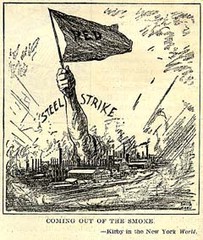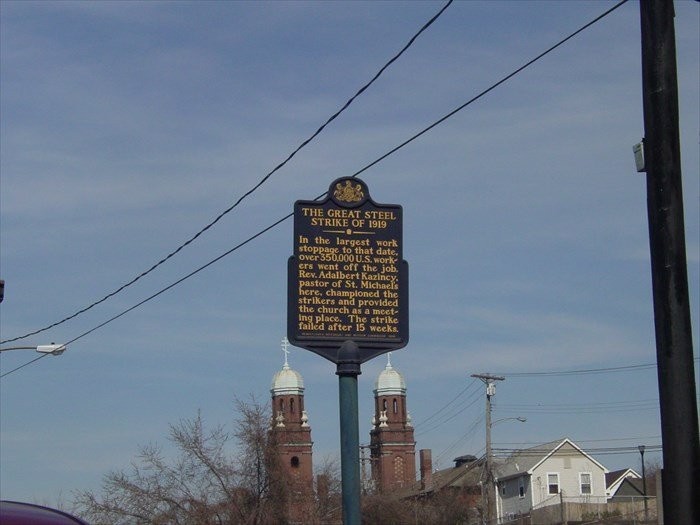Steel Strike of 1919 Historical Marker
Introduction
Text-to-speech Audio
Images
"Coming out of the Smoke," NEW YORK WORLD, October 11, 1919

This marker is located next to the local chapter of the United Steelworkers Union.

Backstory and Context
Text-to-speech Audio
From September 21, 1919, to January 8, 1920, steelworkers in Pittsburgh went on strike against U.S. Steel as a result of post-war downsizing. In total, more than 350,000 workers went on strike during the event. The first movement towards unionization had begun in 1918 and by the summer of 1919, most major steel mill towns had unions. Worker discontent was on the rise and layoffs were frequent in Pennsylvania, Colorado, Illinois, West Virginia, Ohio, and New York. The newly organized unions attempted to negotiate with U.S. Steel, but the company refused to make a deal with union leaders.
Workers wanted better pay and job security as prices across the country skyrocketed between 1915 and 1920. Unions also fought for an 8-hour workday, an improvement on the 48-hour shifts that many mills required. Though some workers saw improvements after the strike, those in the Ohio Valley area were not among them.
Fear of communism was rampant at the time and unions were painted as radicals. Since many mill workers were immigrants, companies and politicians were able to paint striking workers as dangerous communists and prey on the public's xenophobia. In some cities, this was used as a justification to bring in the National Guard and other federal officers to halt strikes. These actions brought violence to the strikes and resulted in several deaths in different cities. Politicians used the strike as an opportunity to promote their agendas and many criticized the strikers for risking the economic development of their cities.
The Great Steel Strike of 1919 collapsed in January 1920, as the final steelworkers went back into the mills in Chicago. The union, the Amalgamated Association of Iron, Steel, and Tin Workers (AA), had been weakened throughout the war years, even as production increased. Technological advances led to a decrease in the need for skilled craftsmen after WWI. The AA fought against the consolidation of steel companies into the U.S. Steel Corporation and ultimately failed to reconcile with the conglomerate. Pittsburgh, the heart of the U.S. steel industry, erupted with discontent.
Though the union collapsed, the New Deal saw a new increase in production and organizing. In 1942, the United Steelworkers organization was established and is currently the largest labor union in North America.
The marker commemorates Reverend Adalbert Kazincy, a priest from St. Michael Parish in Braddock who had assisted European immigrants and helped the workers during the strike.
"A Slovak Strike"
Historian M. Mark Stolarik quoted a superintendent as saying that the strike was a "Slovak strike." Slovak immigrants are largely overlooked in historical scholarship, however. In fact, the Slovak experience in the strike is discussed not in scholarship written by historians but in a novel called Out of This Furnace by Thomas Bell, which follows three generations of one Slovak family living in Western Pennsylvania.
Sources
http://www.iww.org/history/library/MotherJones/autobiography/24 https://libcom.org/history/us-national-steel-strike-1919-jeremy-brecher http://explorepahistory.com/hmarker.php?markerId=1-A-242Great Steel Strike of 1919. Ohio History Central. Accessed March 11, 2019. http://www.ohiohistorycentral.org/w/Great_Steel_Strike_of_1919.
Postwar Labor Tensions. Digital History. 2016. Accessed March 11, 2019. http://www.digitalhistory.uh.edu/disp_textbook.cfm?smtID=2&psid=3382.
1919 Steel Strike. Encyclopedia of Cleveland History. Accessed March 11, 2019. https://case.edu/ech/articles/n/1919-steel-strike.
Stolarik, M. Mark. Slovak-Americans in the Great Steel Strike. Pennsylvania History, vol. 64, no. 3407 - 418. Published August 1st 1997. Jstor.
